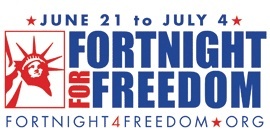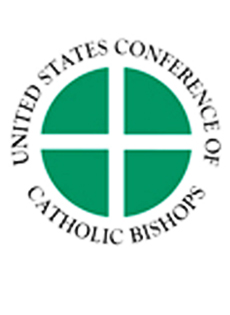
Questions and answers to help Catholics reflect during Fortnight for Religious Freedom
What do we mean by religious liberty?
Sunday, June 23, 2013
*US Conference of Catholic Bishops
This is the first of a two-part blog taken from educational materials prepared by the U.S. Conference of Catholic Bishops. This is the second year the bishops have asked Catholics to observe the Fortnight for Religious Freedom, beginning June 21 and concluding July 4. The box lists the Fortnight for Freedom events taking place in archdiocesan parishes.
What do we mean by religious liberty?
Religious liberty is the first liberty granted to us by God and protected in the First Amendment to our Constitution. It includes more than our ability to go to Mass on Sunday or pray the rosary at home. It also encompasses our ability to contribute freely to the common good of all Americans.
What is the First Amendment?
The First Amendment of the U.S. Bill of Rights states the following: "Congress shall make no law respecting an establishment of religion, or prohibiting the free exercise thereof; or abridging the freedom of speech, or of the press; or the right of the people peaceably to assemble, and to petition the Government for a redress of grievances."

LOCAL FORTNIGHT FOR FREEDOM EVENTS
Little Flower Church in Coral Gables, St. Gregory Church in Plantation and St. Patrick Church in Miami Beach kicked off their Fortnight for Freedom celebrations with Masses and adoration June 21 and 22. Upcoming events include:
- Little Flower, 2711 Indian Mound Trail, Coral Gables: Movie night Monday, June 24, 7:30 p.m., featuring a viewing of "For Greater Glory;” and a candlelight vigil Wednesday, July 3, at 7:30 p.m. For information call Jena Getchell, 786-484-3367.
- St. Gregory, 200 N. University Drive, Plantation: Movie night Tuesday, June 25, 7 p.m., featuring “For Greater Glory;” admission is $5 and refreshments and light snacks will be on sale; candlelight ceremony for religious freedom, Wednesday, July 3, 8 p.m. For information call Mary Sturm, 954-851-3345.
What does "shall make no law respecting an establishment of religion" mean?
This phrase, known as the "Establishment Clause," started out as a prohibition on Congress' either establishing a national religion or interfering with the established religions of the states. It has since been interpreted to forbid state establishments of religion, to forbid governmental preference (at any level) of one religion over another, and to forbid direct government funding of religion.
What does "prohibiting the free exercise thereof" mean?
This phrase, known as the "Free Exercise Clause," generally protects citizens and institutions from government interference with the exercise of their religious beliefs. It sometimes mandates the accommodation of religious practices when such practices conflict with federal, state, or local laws.
What did our early American leaders say about religious freedom?
Who have been heroes of religious liberty in the Church?
Historically, what have been significant religious liberty issues affecting Catholics in our country?
Regardless, anti-Catholic sentiment in the late 19th century led to opposition to parochial schools. State governments opposed providing funds to aid students attending parochial schools, which Catholics founded largely in response to the requirement to pray and read from Protestant Bibles in public schools. Some Members of Congress attempted to block all government aid to religiously affiliated schools with the proposed "Blaine Amendment" in 1875. This constitutional amendment was never ratified at the federal level, but many state legislatures adopted similar legislation and amendments. Those "little Blaine" amendments are still in place in the constitutions of about 37 states, and still operate to block Catholic school students from equal participation in government educational benefits.
During the 1928 presidential campaign, Al Smith, a Catholic who had been elected governor of New York three times, was the Democratic candidate for president. It is widely believed that Smith's Catholic beliefs played a key role in his loss of the 1928 presidential election, as anti-Catholic sentiment among the electorate was strong. Many feared that Smith would answer to the pope and not the constitution if elected president.
During the 1960 presidential campaign, John F. Kennedy's Catholicism became a major issue in the election. Like Al Smith, Kennedy faced charges that he would "take orders from the Pope" and could not uphold the oath of office.
How was religious liberty addressed at the Second Vatican Council (Dignitatis Humanae)?
Dignitatis Humanae provides that "the exercise of religion, of its very nature, consists before all else in those internal, voluntary and free acts whereby man sets the course of his life directly toward God." (Dignitatis Humanae, No. 3.) Therefore, individuals are "not to be forced to act in manner contrary to (their) conscience" nor "restrained from acting in accordance with (their) conscience . . . ." (Id.)
The Second Vatican Council also "declare(d) that the human person has a right to religious freedom. This freedom means that all men are to be immune from coercion on the part of individuals or of social groups and of any human power, in such wise that no one is to be forced to act in a manner contrary to his own beliefs, whether privately or publicly, whether alone or in association with others, within due limits." (Dignitatis Humanae, No. 2.)
Further, Dignitatis Humanae provides that "(r)eligious communities () have the right not to be hindered, either by legal measures or by administrative action on the part of government, in the selection, training, appointment, and transferral of their own Ministers . . . ." (Dignitatis Humanae, No. 4.)
Where are the roots of religious liberty?
Religious liberty is inherent in our very humanity, hard-wired into each and every one of us by our Creator. Religious liberty is also prior to the state itself. It is not merely a privilege that the government grants us and that can be taken away at will.
What has the Church said about religious liberty since Vatican II, for example, through Blessed Pope John Paul II and Pope Benedict XVI?
What does "prohibiting the free exercise thereof" mean?
This phrase, known as the "Free Exercise Clause," generally protects citizens and institutions from government interference with the exercise of their religious beliefs. It sometimes mandates the accommodation of religious practices when such practices conflict with federal, state, or local laws.
What did our early American leaders say about religious freedom?
- George Washington: "If I could have entertained the slightest apprehension that the Constitution framed in the Convention, where I had the honor to preside, might possibly endanger the religious rights of any ecclesiastical society, certainly I would never have placed my signature to it; and if I could now conceive that the general government might ever be so administered as to render the liberty of conscience insecure, I beg you will be persuaded that no one would be more zealous than myself to establish effectual barriers against the horrors of spiritual tyranny, and every species of religious persecution." (Letter to the United Baptist Churches in Virginia, 1789.)
- George Washington: "(T)he conscientious scruples of all men should be treated with great delicacy and tenderness; and it is my wish and desire, that the laws may always be ()extensively accommodated to them…" (Letter to the Annual Meeting of Quakers, 1789.)
- Thomas Jefferson: "No provision in our Constitution ought to be dearer to man than that which protects the rights of conscience against the enterprises of the civil authority." (Letter to New London Methodist, 1809.)
- James Madison: "(T)he equal right of every citizen to the free exercise of his Religion according to the dictates of conscience is held by the same tenure with all our other rights. If we recur to its origin, it is equally the gift of nature; if we weigh its importance, it cannot be less dear to us; if we consult the Declaration of Rights which pertain to the good people of Virginia, as the basis and foundation of Government, it is enumerated with equal solemnity, or rather studied emphasis." (Memorial and Remonstrance Against Religious Assessment, 1785.) (Internal quotation marks omitted.)
- James Madison: "(W)e hold it for a fundamental and undeniable truth that religion, or the duty which we owe our Creator, and the manner of discharging it, can be directed only by reason and conviction, not by force or violence. The Religion then of every man must be left to the conviction and conscience of every man; and it is the right of every man to exercise it as these may dictate." (Memorial and Remonstrance Against Religious Assessment, 1785.) (Internal citation and quotations omitted.)
Who have been heroes of religious liberty in the Church?
- St. Thomas More: Thomas More was an English Catholic lawyer who served as Lord Chancellor and a close advisor to King Henry VIII. Moreopposed the king's separation from the Catholic Church and his naming himself as Supreme Head of the Church of England. More was imprisoned for his refusal to take the oath required by a law that disparaged papal power and required acknowledging the children of Henry and Anne Boleyn (the king's second wife after his divorce from Catherine of Aragon) as legitimate heirs to the throne. In 1535, More was tried for treason, convicted on perjured testimony, and beheaded. He is the patron saint of religious freedom.
- St. John Fisher: John Fisher was an English Catholic cardinal, academic, and martyr. Fisher was executed by order of King Henry VIII during the English Reformation for refusing to accept the king as Supreme Head of the Church of England and for upholding the Catholic Church's doctrine of papal primacy.
- St. Elizabeth Ann Seton: Elizabeth Ann Seton was the first native-born U.S. citizen to be canonized by the Catholic Church. In 1809, Seton founded the first American congregation of Religious Sisters, the Sisters of Charity. She also established the first parochial school for girls in the U.S. in Emmitsburg, Maryland in 1810. Seton's efforts initiated the parochial school system in America and opened the first free Catholic schools for the poor.
- St. Katharine Drexel: Katharine Drexel was a religious sister, heiress, philanthropist, and educator. She dedicated herself and her inheritance to the needs of oppressed Native Americans and African-Americans in the western and southwestern United States. She was a vocal advocate of racial tolerance and established a religious congregation, the Sisters of the Blessed Sacrament, whose mission was to teach African-Americans and later American Indians. She also financed more than 60 missions and schools around the United States, in addition to founding Xavier University of Louisiana—the only historically African-American Catholic university in the United States to date.
- John Courtney Murray, SJ: Father Murray was an American Jesuit priest and theologian who was known for his efforts to reconcile Catholicism and religious pluralism, particularly focusing on the relationship between religious freedom and the institutions of a democratically structured modern state. During the Second Vatican Council, he played a key role in the Council's ground-breaking Declaration on Religious Liberty, Dignitatis Humanae.
Historically, what have been significant religious liberty issues affecting Catholics in our country?
- Equal treatment of Catholic schools:
Regardless, anti-Catholic sentiment in the late 19th century led to opposition to parochial schools. State governments opposed providing funds to aid students attending parochial schools, which Catholics founded largely in response to the requirement to pray and read from Protestant Bibles in public schools. Some Members of Congress attempted to block all government aid to religiously affiliated schools with the proposed "Blaine Amendment" in 1875. This constitutional amendment was never ratified at the federal level, but many state legislatures adopted similar legislation and amendments. Those "little Blaine" amendments are still in place in the constitutions of about 37 states, and still operate to block Catholic school students from equal participation in government educational benefits.
- Anti-Catholic bigotry in presidential campaigns:
During the 1928 presidential campaign, Al Smith, a Catholic who had been elected governor of New York three times, was the Democratic candidate for president. It is widely believed that Smith's Catholic beliefs played a key role in his loss of the 1928 presidential election, as anti-Catholic sentiment among the electorate was strong. Many feared that Smith would answer to the pope and not the constitution if elected president.
During the 1960 presidential campaign, John F. Kennedy's Catholicism became a major issue in the election. Like Al Smith, Kennedy faced charges that he would "take orders from the Pope" and could not uphold the oath of office.
- Establishment of diplomatic relations with the Vatican:
How was religious liberty addressed at the Second Vatican Council (Dignitatis Humanae)?
Dignitatis Humanae provides that "the exercise of religion, of its very nature, consists before all else in those internal, voluntary and free acts whereby man sets the course of his life directly toward God." (Dignitatis Humanae, No. 3.) Therefore, individuals are "not to be forced to act in manner contrary to (their) conscience" nor "restrained from acting in accordance with (their) conscience . . . ." (Id.)
The Second Vatican Council also "declare(d) that the human person has a right to religious freedom. This freedom means that all men are to be immune from coercion on the part of individuals or of social groups and of any human power, in such wise that no one is to be forced to act in a manner contrary to his own beliefs, whether privately or publicly, whether alone or in association with others, within due limits." (Dignitatis Humanae, No. 2.)
Further, Dignitatis Humanae provides that "(r)eligious communities () have the right not to be hindered, either by legal measures or by administrative action on the part of government, in the selection, training, appointment, and transferral of their own Ministers . . . ." (Dignitatis Humanae, No. 4.)
Where are the roots of religious liberty?
Religious liberty is inherent in our very humanity, hard-wired into each and every one of us by our Creator. Religious liberty is also prior to the state itself. It is not merely a privilege that the government grants us and that can be taken away at will.
What has the Church said about religious liberty since Vatican II, for example, through Blessed Pope John Paul II and Pope Benedict XVI?
- Blessed John Paul II: "(T)he most fundamental human freedom (is) that of practicing one's faith openly, which for human beings is their reason for living." (Address to Diplomatic Corps, 13 Jan. 1996, No. 9.)
- Pope Benedict XVI: "(Religious freedom) is indeed the first of human rights, not only because it was historically the first to be recognized but also because it touches the constitutive dimension of man, his relation with his Creator." (Address to Diplomatic Corps, 10 Jan. 2011.)
- The distinction between Church and State, between God and Caesar, remains "fundamental to Christianity." (Deus Caritas Est, No. 28.) The Church has "a proper independence and is structured on the basis of her faith as a community which the State must recognize." (Id.)


Comments from readers